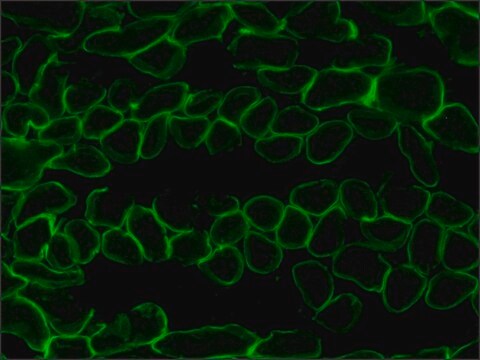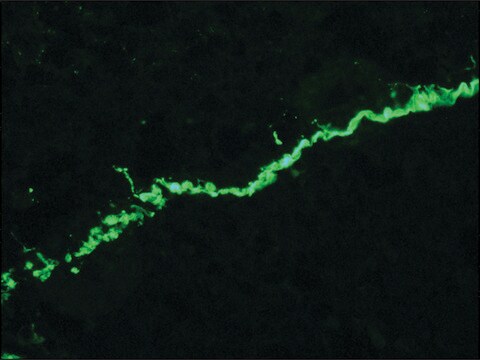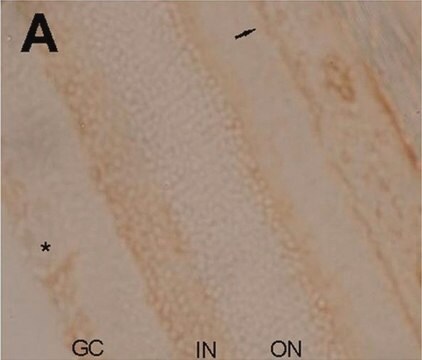推荐产品
無性繁殖
AW39R
品質等級
物種活性
mouse (05-538SP), Xenopus, chicken, human (05-538SP), rat
製造商/商標名
Upstate®
濃度
1 mg/mL (05-538SP)
技術
activity assay: suitable (kinase and phosphatase)
flow cytometry: suitable
immunofluorescence: suitable
multiplexing: suitable
western blot: suitable
運輸包裝
dry ice
基因資訊
human ... MAP2K1(5604) , RAF1(5894)
一般說明
Pathway Explorer Antibody MiniPack:
Each Pathway Explorer Antibody Minipack contains three related antibodies as part of a signaling cascade or a combination of total and phosphorylated forms of key signaling targets. Each of the three antibodies are 30% the original pack size. Full size versions of each of the Pathway Explorer antibodies are available for sale individually under the same catalog number with the removal of “SP” off of each one (e.g. 05-591SP can be ordered as 05-591).
Erk1/2:
Erk (Extracellular signal-Related Kinase) is a family of two, highly homologous proteins denoted as Erk1 (p44, MAPK3) and Erk2 (p42, MAPK1) that both function in the same pathway. The two proteins are often referred to collectively as Erk1/2 or p44/p42 MAP kinase. The Erk pathway is considered the classical, canonical MAPK (Mitogen-Activated Protein Kinase) signaling pathway. It is an evolutionarily conserved pathway that controls and is a critical regulator of the growth and survival through the promotion of cell proliferation and the prevention of apoptosis. Erk is involved in the control of many fundamental cellular processes including cell proliferation, survival, differentiation, apoptosis, motility and metabolism. Erk is activated by growth factor stimulation of receptor tyrosine kinases (RTKs), GPCR, and/or integrin stimulation. This activates the Ras-Raf-MEK-Erk pathway that results in the phosphorylation/activation of Erk1/2 (p44/p42) on the TxY motif (Thr202/Tyr204 and Thr185/Tyr187 for Erk1 & Erk2, respectively).
Raf:
The Raf proteins (A-Raf, B-Raf, Raf-1/c-Raf) are Ser/Thr kinases with homology to the PKC family, containing an N-terminal regulatory domain and a C-terminal catalytic domain. Raf (MAP Kinase Kinase Kinase) is the top kinase in the canonical MAPK pathway. Members of the Raf family bind to activated Ras. Ras, in its GTP-bound active state, activates the kinase activity of Raf. This results in Raf translocation to the plasma membrane and activation. Once activated, Raf then binds to and activates MEK (MAP Kinase Kinase) by phosphorylating it on the two residue motif. It is thought that B-Raf might be the predominant activator of MEK and that Raf-1 has a role in protection against apoptosis; a process that does not require either its kinase activity or its activation of MEK. The regulation of a large number of cellular processes are dependent upon the activation state of ERK, so the controlling of this pathway could have profound effects on various diseases. Activation of Raf-1 involves phosphorylation of Ser338/339 and Tyr340/341. Activating mutations of B-Raf that disrupt its auto-inhibition loop have been implicated in a number of cancers, including melanoma and colon cancer.
MEK1/MEK2:
MAP Kinase/Erk Kinase (MEK), alternatively known as MKK, is a true dual-specificity kinase, in that it phosphorylates the MAP kinases (Erk1/2; p44/p42)) on both the Thr and Tyr of the activation motif TEY. In vitro, the tyrosine phosphorylation is favored, whereas in vivo both phosphorylation events appear to occur simultaneously. This suggests that an additional factor is present in cells to facilitate the reaction. MEK1 and MEK2 are activated by phosphorylation of two serine residues (Ser218/222 in MEK1 and Ser222/226 in MEK2), which are substrates for the Raf family of kinases. Mutation of the phosphorylation sites from Ser to Asp creates a protein with constitutive kinase activity, which when expressed in cells is able to cause transformation.
* See full size versions for corresponding references.
Each Pathway Explorer Antibody Minipack contains three related antibodies as part of a signaling cascade or a combination of total and phosphorylated forms of key signaling targets. Each of the three antibodies are 30% the original pack size. Full size versions of each of the Pathway Explorer antibodies are available for sale individually under the same catalog number with the removal of “SP” off of each one (e.g. 05-591SP can be ordered as 05-591).
Erk1/2:
Erk (Extracellular signal-Related Kinase) is a family of two, highly homologous proteins denoted as Erk1 (p44, MAPK3) and Erk2 (p42, MAPK1) that both function in the same pathway. The two proteins are often referred to collectively as Erk1/2 or p44/p42 MAP kinase. The Erk pathway is considered the classical, canonical MAPK (Mitogen-Activated Protein Kinase) signaling pathway. It is an evolutionarily conserved pathway that controls and is a critical regulator of the growth and survival through the promotion of cell proliferation and the prevention of apoptosis. Erk is involved in the control of many fundamental cellular processes including cell proliferation, survival, differentiation, apoptosis, motility and metabolism. Erk is activated by growth factor stimulation of receptor tyrosine kinases (RTKs), GPCR, and/or integrin stimulation. This activates the Ras-Raf-MEK-Erk pathway that results in the phosphorylation/activation of Erk1/2 (p44/p42) on the TxY motif (Thr202/Tyr204 and Thr185/Tyr187 for Erk1 & Erk2, respectively).
Raf:
The Raf proteins (A-Raf, B-Raf, Raf-1/c-Raf) are Ser/Thr kinases with homology to the PKC family, containing an N-terminal regulatory domain and a C-terminal catalytic domain. Raf (MAP Kinase Kinase Kinase) is the top kinase in the canonical MAPK pathway. Members of the Raf family bind to activated Ras. Ras, in its GTP-bound active state, activates the kinase activity of Raf. This results in Raf translocation to the plasma membrane and activation. Once activated, Raf then binds to and activates MEK (MAP Kinase Kinase) by phosphorylating it on the two residue motif. It is thought that B-Raf might be the predominant activator of MEK and that Raf-1 has a role in protection against apoptosis; a process that does not require either its kinase activity or its activation of MEK. The regulation of a large number of cellular processes are dependent upon the activation state of ERK, so the controlling of this pathway could have profound effects on various diseases. Activation of Raf-1 involves phosphorylation of Ser338/339 and Tyr340/341. Activating mutations of B-Raf that disrupt its auto-inhibition loop have been implicated in a number of cancers, including melanoma and colon cancer.
MEK1/MEK2:
MAP Kinase/Erk Kinase (MEK), alternatively known as MKK, is a true dual-specificity kinase, in that it phosphorylates the MAP kinases (Erk1/2; p44/p42)) on both the Thr and Tyr of the activation motif TEY. In vitro, the tyrosine phosphorylation is favored, whereas in vivo both phosphorylation events appear to occur simultaneously. This suggests that an additional factor is present in cells to facilitate the reaction. MEK1 and MEK2 are activated by phosphorylation of two serine residues (Ser218/222 in MEK1 and Ser222/226 in MEK2), which are substrates for the Raf family of kinases. Mutation of the phosphorylation sites from Ser to Asp creates a protein with constitutive kinase activity, which when expressed in cells is able to cause transformation.
* See full size versions for corresponding references.
特異性
05-538SP: Predicted to cross react with rat, chicken and Xenopus based on sequence homology.
05-797RSP: Recognizes Erk 1 & 2 only when dually phosphorylated on its TxY activation motif.; 05-747SP: Phosphorylated MEK1/MEK2; 05-538SP: Recognizes Raf-1 phosphorylated at Serine 338
免疫原
05-797RSP: Phosphorylated peptide encompassing the TxY motif in the activation loop of Erk1 and Erk2.; 05-747SP: KLH-conjugated, synthetic peptide containing …DpSMANpSF… in which pS corresponds to phosphorylated amino acids 218 and 222 of human MEK1. The immunizing sequence is highly conserved.;05-538SP:KLH-conjugated, synthetic peptide encompassing and including phosphorylated Ser338 of human Raf-1. The immunizing sequence is identical in rat and chicken and has 12/13 identical amino acids in Xenopus.
Epitope: Please see relevant data sheet.
應用
05-797RSP: Immunofluorescence Analysis: A431 cells were fixed, permabilized and dual stained with anti-phospho-Erk.
Flow Cytometry Analysis:Jurkat cells were fixed, permeablized, and stained with anti-phospho-Erk 1/2 (Thr202/Tyr204, Thr185/Tyr187).
Flow Cytometry Analysis:Jurkat cells were fixed, permeablized, and stained with anti-phospho-Erk 1/2 (Thr202/Tyr204, Thr185/Tyr187).
Research Category
Signaling
Apoptosis & Cancer
Signaling
Apoptosis & Cancer
Research Sub Category
MAP Kinases
MAP Kinases
This Antibody pack contains Anti-phospho-Raf-1 Antibody(Ser338), Anti-phospho-MEK1 Antibody(Ser218/222)/ MEK2 (Ser222/226), Anti-phospho-Erk 1/2 Antibody (Thr202/Tyr204, Thr185/Tyr187), validated for use in IF, Flow, WB, Multiplexing
包裝
Each vial is 30% the size of the parent catalog number
成分
05-538SP Anti-phospho-Raf-1 (Ser338)
05-747SP Anti-phospho-MEK1 (Ser218/222)/ MEK2 (Ser222/226)
05-797RSP Anti-phospho-Erk 1/2
(Thr202/Tyr204, Thr185/Tyr187), recombinant clone AW39R
05-747SP Anti-phospho-MEK1 (Ser218/222)/ MEK2 (Ser222/226)
05-797RSP Anti-phospho-Erk 1/2
(Thr202/Tyr204, Thr185/Tyr187), recombinant clone AW39R
標靶描述
05-797RSP: 42 and 44 kDa; 05-747SP: 45 kDa; 05-538SP: 74 kDa
外觀
3 individual tubes containing either Anti-phospho-Raf-1 (Ser338); or Anti-phospho-MEK1 (Ser218/222)/ MEK2 (Ser222/226); Anti-phospho-Erk 1/2
(Thr202/Tyr204, Thr185/Tyr187), recombinant clone AW39R
(Thr202/Tyr204, Thr185/Tyr187), recombinant clone AW39R
Format: Purified
儲存和穩定性
Stable for 1 year at -20°C from date of receipt.
Handling Recommendations: Upon receipt, and prior to removing the cap, centrifuge the vial and gently mix the solution. Aliquot into microcentrifuge tubes and store at -20°C. Avoid repeated freeze/thaw cycles, which may damage IgG and affect product performance.
Handling Recommendations: Upon receipt, and prior to removing the cap, centrifuge the vial and gently mix the solution. Aliquot into microcentrifuge tubes and store at -20°C. Avoid repeated freeze/thaw cycles, which may damage IgG and affect product performance.
分析報告
Control
05-538SP:3T3/NIH cells
05-538SP:3T3/NIH cells
法律資訊
UPSTATE is a registered trademark of Merck KGaA, Darmstadt, Germany
免責聲明
Unless otherwise stated in our catalog or other company documentation accompanying the product(s), our products are intended for research use only and are not to be used for any other purpose, which includes but is not limited to, unauthorized commercial uses, in vitro diagnostic uses, ex vivo or in vivo therapeutic uses or any type of consumption or application to humans or animals.
儲存類別代碼
10 - Combustible liquids
Stefanie Roth et al.
Nature protocols, 5(12), 1967-1973 (2010-12-04)
A concise and highly efficient synthetic route to L-azidohomoalanine (L-Aha) and its homologues is presented here. These chemically modified amino acids are used for the introduction of bioorthogonal handles into proteins. The described route avoids major problems of previously reported
我们的科学家团队拥有各种研究领域经验,包括生命科学、材料科学、化学合成、色谱、分析及许多其他领域.
联系技术服务部门








